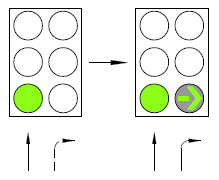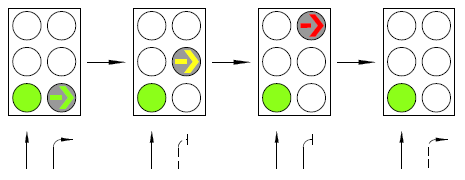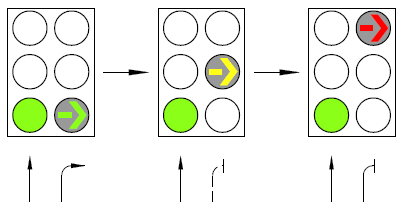4. Crashes at traffic signals
An analysis undertaken by Tim Hughes of Land Transport NZ identified the main safety issues at traffic signals as follows:
| right-turn-against crashes |
32% |
| failed to stop for red |
30% |
| pedestrians |
14% |
| cyclists |
8% |
Subsequent sections of this guide will give some guidance on how the safety performance of signals can be improved.
4.1 Factors contributing to right-turn-against crashes
The following factors can contribute to right-turn-against crashes:
- compromised visibility due to geometry.
- misjudging speed, especially on multilane roads.
- turning on yellow when one lane has stopped, but drivers in adjacent lanes proceed.
- misjudging intentions of opposing traffic - are they proceeding through or turning left?
- use of phasing and arrows.
Compared to full filtering, the following crash rate reductions have been identified (Hall, 1993):
- 30% for filter right turns, followed by a right turn arrow (a lag right turn).

- 68% for a right turn arrow, followed by filtering (a lead right turn).

- 90% for a lead right turn, followed by a red arrow (no filter).

4.2 Factors contributing to red light running
The following factors can contribute to unintentional red light running:
- Poor conspicuity of signal displays
- Anticipation of phase progression
- Inconsistent phasing at adjacent intersections
In addition, drivers may be tempted into intentional red light running when they experience a poor level of service, especially when combined with a low expectation of enforcement.
4.3 Observations on cyclist crashes
- In three quarters of the cases, the crashes are caused by motorists.
- Cyclists would benefit by having space allocated to them (especially for the through movement) and colour highlighting that space.
- A simplification of the Give Way rules would help.
4.4 Observations on pedestrian crashes
- Wide intersections intimidate pedestrians.
- Drivers are often distracted (from seeing pedestrians) by other vehicles.
- Slip lanes are generally safe for pedestrians (but large radii should be avoided).
- A simplification of the Give Way rules would help.
< previous | next >



